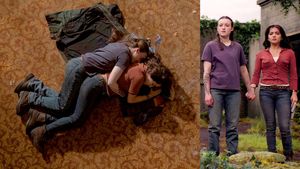(CNN) — Editor’s note: Ken Dorph is a consultant who lives in Sag Harbor, New York. The views expressed in this commentary are his own. Read more opinion at CNN.
Last year, I was invited to be Santa at the Sag Harbor Cinema, the renovated art deco movie theater in the quaint whaling town of Sag Harbor, New York. For more than 30 years, I have been a resident of this small village; I have found that Sag Harbor’s whaling DNA and its feisty, independent character have suited me. From Betty Friedan to John Steinbeck, this small place has hosted an array of artists, intellectuals and independent thinkers.
I loved being Santa and was told that I was a natural. I adored chatting with the little ones, and I fully inhabited the role. I always told them that Santa could tell that they were a very good girl or boy. I tried to be Santa for everyone. When the local rabbi’s young daughter was shepherded over to me by the elves, I told her that Santa loved everyone. We had a delightful chat. The eyes of Guatemalan parents widened when I spoke Spanish. The little ones however didn’t skip a beat: Claro, Santa speaks Spanish. Didn’t you see ”Miracle on 34th Street”?
The local paper did a wonderful interview with me as Santa, with reporters asking silly questions, such as whether Santa had ever run into Krampus and what Santa’s favorite cookies were. The Sag Harbor Chamber of Commerce later hired me to be their St. Nick as well. The Chamber Santa Claus flies into the Village, ringing the bell on the firetruck before meeting kids at the windmill.
The original Saint Nicholas, who bequeathed his name to our Santa Claus via the Dutch Sinterklaas, lived in present day Turkey. In Western cultures, our own Santa took that seed and mingled it with Nordic traditions, including the concept of Yule.
In the 1930s, Swedish-born artist Haddon Sundblom used his very Scandinavian face as the model for the famed Coca Cola ads, cementing the look. Of course, nowadays Santa could be Black, transgender, or Chinese, but that image is still the one that stares back at kids from their books. Santa is special, a kindly grandfatherly magician who answers kids’ dreams. That’s why I have so loved inhabiting this character.
But the spirit of Santa speaks to me for other reasons having to do with my own journey of cross cultural discovery and outreach. For decades, I have been in an unusual position. On one hand, I am emotionally attached to Jewish culture. I grew up in a housing project in Brooklyn that was overwhelmingly Ashkenazi Jewish. I was a Shabbos goy and knew neighbors who had tattoos from the camps. I went to Stuyvesant High School, and then to the State University of New York at Binghamton, both of which had sizable Jewish student populations. Jewish culture was and, in many ways, remains one with which I feel an emotional connection.
Then at 19, I went to Morocco. The trip was part of a junior year abroad that changed my life. I ended up spending years in the Arab world, first as a student then as a professional. I am fluent in Arabic and have worked throughout the Middle East, including being part of repair teams in nations broken by American weapons, including Iraq, Yemen, Syria, Palestine, and Libya.
In the Middle East, I developed deep and abiding ties with the people from the Arab world. And given my experience in the region, I am often asked to talk about it. After the horrific Hamas attack and the devastating Israeli response, several friends and neighbors asked what I thought. On October 28th, I gave a talk at a local church in Sag Harbor entitled, “Palestine / Israel: What Gives?” to a full house. The reaction was overwhelmingly positive.
About a month later, I was invited to attend a lecture at the local synagogue — this time as an audience member — on the topic of “Answering the Tough Questions” about Israel. Given the intriguing title, I perceived the invitation as an olive branch. I thought, perhaps narcissistically, that I was specifically invited for my unique Middle East expertise.
I could not have been more wrong. The talk seemed intended to offer instruction on how to deflect tough questions challenging the government of Benjamin Netanyahu and its violence against the Palestinians, rather than inform. I confronted the speaker to counter what I considered inaccuracies in the presentation and when it was over, I shared how disappointing I found it. The talk was unhelpful and sounded to my ears like a propaganda session.
I pointed out that it did not remotely address the “tough questions” needed to help bring about peace in the region. The presentation seemed a missed opportunity to have real discussion, at a time when thousands of Palestinians were being killed by American weapons.
Several days later, I received an email from Sag Harbor’s Chamber of Commerce informing me that I was to hand in my fur-trimmed red suit, wide black belt and jingles: I was deemed to be too outspoken to be Santa. I was devastated. Not only was I sad for losing the chance to ride in the Village on the firetruck in all my jolly glory, but I felt thwacked in my bowlful of jelly for speaking out in another life, as another character.
A journalist friend contacted the New York Times, and a reporter contacted me. After some agonizing — this is a small town, after all — I decided that I had to share what happened. The newspaper published the story, which was picked up globally. I’m happy to say that, since the story came out, I have been invited to be Santa Claus all over the United States and beyond.
Unsurprisingly, this controversy has amplified the debate about how and whether we can talk about Israel and the Palestinian people without castigation. I fervently hope that the ill will it has stirred locally will transform into good will.
I am a firm believer, from my work in my consulting practice — the business run by my non-Santa self — that the more open and informed discussions we have, the more likely we are to reach the best solutions. I hope that even holds true for the allegedly intractable Middle East.
The tragic relationship between Israelis and Palestinians is not a hurricane or earthquake. It is a human-made problem, and it can have human-made solutions. Indeed, we humans are the only ones who can solve it.
The-CNN-Wire
™ & © 2023 Cable News Network, Inc., a Warner Bros. Discovery Company. All rights reserved.

Video Source: Advocate Channel
- Here Are Ways You Can Help Palestinian Civilians That Aren't Just Donating ›
- Disabled Palestinians Struggle to Survive in Gaza: 'Isolated From the World' ›
- Nearly Half of All Israeli Bombs Dropped on Gaza are Imprecise ‘Dumb Bombs' ›
- Queering the Map in Gaza: LGBTQ+ Palestinians Pay Tribute to Deceased Loved Ones ›


















































